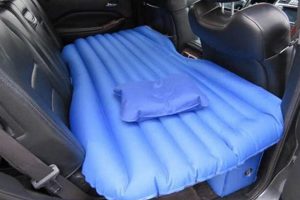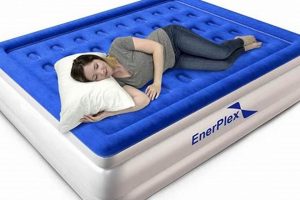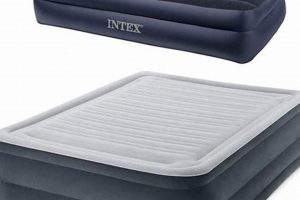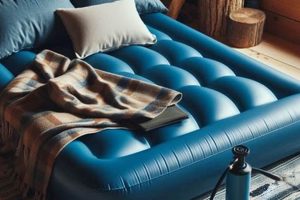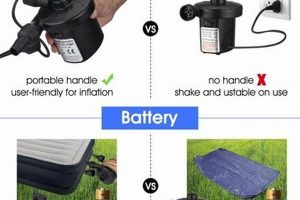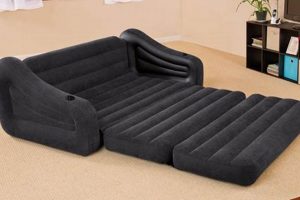Determining the source of escaping air within an inflatable sleeping surface is essential for maintaining its functionality and comfort. This process involves methodical examination to pinpoint the precise location of the imperfection causing deflation.
Identifying the compromised area extends the lifespan of the product, prevents discomfort during use, and minimizes the need for replacement, thereby providing economic and practical advantages. Historically, various methods have been employed, evolving from simple visual checks to more sophisticated techniques involving soapy solutions and auditory detection.
The subsequent sections will detail several effective procedures for locating these imperfections, ranging from basic visual inspections to more involved approaches requiring common household items.
Strategies for Identifying Air Escape Points
The following strategies provide a structured approach to identifying the source of air loss in an inflatable sleeping surface, ensuring thorough examination and efficient repair.
Tip 1: Visual Inspection: Commence with a meticulous visual scan of the entire surface, paying particular attention to seams, valves, and areas prone to stress. Look for any signs of punctures, tears, or abrasions. Examine the mattress in a well-lit area to enhance visibility.
Tip 2: Auditory Detection: Inflate the mattress to its maximum recommended capacity and listen closely for any hissing sounds. Move slowly along the surface, concentrating on areas where air escape is suspected. In a quiet environment, even small imperfections can produce an audible sound.
Tip 3: Soapy Water Test: Mix a solution of mild soap and water. Apply the solution to small sections of the inflated mattress using a sponge or spray bottle. Observe the surface for the formation of bubbles, which indicate escaping air. Thoroughly dry the tested area after inspection.
Tip 4: Submersion Method: If practical, submerge sections of the inflated mattress into a tub or pool of water. Observe for air bubbles rising from the submerged area. This method is particularly effective for identifying small imperfections that may be difficult to locate otherwise.
Tip 5: Valve Examination: Inspect the valve mechanism closely. Ensure the valve is properly sealed and free from debris. Apply soapy water to the valve area to check for air leakage around the seal.
Tip 6: Pressure Sensitivity: With the mattress fully inflated, apply gentle pressure to various areas. Listen for any changes in the sound of escaping air, which may help pinpoint the location of a small imperfection.
These strategies, when employed systematically, significantly increase the likelihood of identifying the compromised area. Prompt detection and repair are crucial for preserving the functionality and longevity of the inflatable sleeping surface.
The subsequent section will address common repair techniques and preventative measures to minimize future occurrences.
1. Auditory Detection
Auditory detection serves as an initial and often effective method in the systematic process of locating air egress points within an inflatable sleeping surface. It leverages the human ear’s ability to discern subtle sounds indicative of escaping air.
- Ambient Noise Considerations
The efficacy of auditory detection is directly influenced by the ambient sound levels. A quiet environment is paramount for identifying subtle hissing sounds emanating from small imperfections. External noises, such as traffic or machinery, can mask these sounds, rendering the method less effective. Conducting the test in a controlled, quiet space is crucial for accurate results.
- Proximity and Scanning Technique
The proximity of the ear to the surface of the inflated mattress significantly impacts the ability to detect escaping air. A methodical scanning technique, involving slow and deliberate movement across the surface, ensures comprehensive coverage. Concentrating on seams, valves, and areas suspected of damage maximizes the likelihood of detection.
- Frequency and Pitch Recognition
Different sized imperfections produce varying frequencies and pitches of sound. Larger perforations may generate a louder, more easily discernible hissing noise, while smaller pinholes may emit a higher-pitched, subtler sound. Training the ear to recognize these subtle variations enhances detection capabilities. Focusing on changes in sound characteristics can indicate the precise location of the compromised area.
- Limitations and Complementary Methods
Auditory detection, while valuable, possesses limitations. Small or slow leaks may not produce audible sounds, necessitating the use of complementary methods such as soapy water tests or submersion techniques. Auditory detection serves as a preliminary step, guiding the subsequent application of more definitive leak detection methods.
The successful application of auditory detection, characterized by a controlled environment, meticulous scanning, and sound frequency recognition, contributes significantly to the overall process of identifying air egress points, often initiating the cascade of methods employed in addressing the loss of air pressure in inflatable sleeping surfaces.
2. Soapy Water
The application of soapy water represents a crucial and demonstrably effective methodology in locating air egress points within inflatable sleeping surfaces. Its utility stems from the solution’s ability to visually amplify the presence of escaping air, facilitating accurate identification of the source of deflation.
- Bubble Formation Mechanism
The efficacy of soapy water rests on the principle of surface tension reduction. Soap molecules decrease the surface tension of water, allowing air escaping from a small imperfection to form distinct bubbles. These bubbles, larger and more visible than the air leak itself, pinpoint the compromised area. The size and rate of bubble formation correlate with the magnitude of the air escape.
- Solution Preparation and Application Techniques
The ideal soapy water solution involves a mild dish soap diluted in water. Excessive soap concentration can leave a residue, while insufficient concentration diminishes bubble formation. Application methods include spraying the solution onto the inflated surface or using a sponge to apply a thin, even layer. Careful observation is paramount to detect the subtle formation of bubbles, particularly in areas with minimal air leakage.
- Identifying Difficult-to-Locate Imperfections
Soapy water proves particularly valuable in identifying minute punctures or slow leaks that may be undetectable through visual inspecti
on or auditory methods alone. The solution’s ability to amplify the presence of escaping air allows for the precise localization of these imperfections, enabling targeted repair efforts. - Post-Application Procedures and Precautions
Following the application of soapy water, thorough drying of the surface is essential to prevent water damage or mold growth. Residue from the soap solution should be removed to avoid attracting dirt or compromising the material’s integrity. Consideration must be given to the mattress material compatibility with the soap solution to avoid adverse reactions.
In summary, the strategic deployment of soapy water, underpinned by a sound understanding of its operational principles and application protocols, plays an indispensable role in the comprehensive identification of air egress points, contributing substantially to the preservation of inflatable sleeping surfaces.
3. Visual Inspection
Visual inspection constitutes the foundational step in identifying air leaks within an inflatable sleeping surface. The premise is straightforward: a thorough examination of the mattress’s exterior can reveal macroscopic damage responsible for air egress. Tears, punctures, abrasions, and seam failures are all potential indicators detectable through careful visual scrutiny. For instance, a pet’s claw might create a visible puncture, or repeated folding along a seam might lead to a clearly discernible tear. The success of this initial stage directly impacts the efficiency of subsequent leak detection efforts; identifying the source visually obviates the need for more involved techniques.
The efficacy of visual inspection is directly proportional to the thoroughness and attentiveness of the individual performing it. Utilizing adequate lighting is paramount; a dimly lit environment may obscure subtle imperfections. Furthermore, systematically scanning the entire surface, rather than focusing solely on areas of suspected damage, maximizes the likelihood of discovering all compromised locations. Real-world applications underscore this: a slow leak might stem from a nearly imperceptible pinhole puncture, rendering a cursory visual scan insufficient. Conversely, a large, obvious tear simplifies the process significantly. Therefore, visual inspection functions as a primary filter, potentially resolving the issue swiftly or guiding further investigation when the damage is not immediately apparent.
In conclusion, visual inspection serves as the cornerstone of any strategy to locate air leaks. Its simplicity belies its importance; a diligent visual assessment can resolve the issue outright or, at a minimum, narrow the search area, significantly streamlining the overall leak detection process. Despite its limitations in detecting microscopic damage, it remains the indispensable first step, setting the stage for more sophisticated methods when required and ensuring an effective and efficient approach to maintaining the integrity of inflatable sleeping surfaces.
4. Valve Integrity
Valve integrity represents a critical factor in maintaining air pressure within an inflatable mattress. The valve mechanism, designed to both inflate and seal the mattress, constitutes a common point of failure, necessitating careful examination when addressing air loss. Its proper function directly impacts the mattress’s ability to retain air, making it a primary suspect in investigations concerning deflation.
- Valve Seal Examination
The valve seal, typically composed of rubber or a similar pliable material, is responsible for creating an airtight barrier. Over time, this seal can degrade, become cracked, or accumulate debris, compromising its ability to prevent air leakage. Examination involves both visual inspection for physical damage and a tactile assessment to ensure proper alignment and closure. A compromised seal necessitates either cleaning, adjustment, or complete replacement to restore functionality.
- Valve Core Tightness and Functionality
Many valves incorporate a core mechanism, similar to that found in a tire valve. This core, often threaded, must be securely tightened to prevent air escape. Over-tightening, however, can damage the core or the surrounding valve body. Inspection includes verifying the core’s tightness and assessing its internal mechanism for proper operation. A malfunctioning core will require tightening, replacement, or specialized tools for repair, contingent upon the design and extent of the damage.
- Valve Body Integrity and Connection
The valve body, typically constructed from plastic or metal, houses the sealing mechanism and connects to the mattress material. Cracks, fractures, or loose connections between the valve body and the mattress fabric create pathways for air to escape. Careful inspection of the valve body for structural damage, along with assessment of the connection point for secure bonding, is essential. Repairing a damaged valve body may require specialized adhesives or replacement of the entire valve assembly.
- One-Way Valve Functionality (if applicable)
Some air mattresses utilize one-way valves designed to prevent air from escaping during inflation. These valves often incorporate a flapper or diaphragm that allows air to enter but restricts its egress. Failure of this mechanism, whether due to debris obstruction or material degradation, can result in unintended air leakage. Inspection involves verifying the proper operation of the one-way valve and ensuring it seals effectively after inflation. Cleaning or replacing the valve may be necessary to restore its one-way functionality.
The facets of valve integrity highlight its indispensable role in air retention. A systematic evaluation of the valve mechanism, encompassing seal condition, core functionality, body integrity, and one-way valve performance (if applicable), provides a comprehensive assessment of its contribution to air loss. Addressing any identified deficiencies in the valve’s operation constitutes a primary step in mitigating air leakage and restoring the functionality of the inflatable mattress.
5. Submersion Test
The submersion test provides a direct means of identifying air egress points, forming a critical component in the overall process. Its effectiveness stems from the distinct visual indicator it provides: escaping air manifests as a stream of bubbles when the inflated object is immersed in water. This method is particularly valuable when other leak detection techniques, such as auditory or soapy water tests, prove inconclusive, especially in situations involving very small or intermittent leaks.
The practical application of the submersion test requires a container large enough to accommodate sections of the air mattress. The mattress is inflated, and portions are gradually submerged while carefully observing for the emergence of air bubbles. The presence, frequency, and location of these bubbles directly correspond to the site of air loss. Real-world examples frequently demonstrate the method’s utility: a slow leak caused by a minute puncture, nearly impossible to detect visually, becomes readily apparent through the continuous re
lease of air bubbles underwater. This level of precision is crucial for effectively targeting repair efforts. For instance, it enables the exact placement of a patch, minimizing wasted materials and maximizing the chances of a successful repair.
While highly effective, the submersion test presents certain limitations. Its practicality diminishes with larger mattresses due to the logistical challenges of complete immersion. Furthermore, the process necessitates thorough drying of the mattress to prevent moisture damage and mold growth. Despite these challenges, the submersion test remains a highly valuable tool for pinpointing elusive air leaks, particularly when integrated with other diagnostic methods, leading to a successful resolution for issues with air mattress deflation.
6. Pressure Sensitivity
Pressure sensitivity, as a diagnostic technique, involves applying localized force to an inflated mattress to identify or exacerbate air leakage. This method leverages the principle that increased pressure near an imperfection can amplify air escape, making it easier to detect the source of the leak.
- Amplification of Subtle Leaks
Pressure sensitivity proves most valuable in identifying subtle leaks that are difficult to detect via visual inspection, auditory methods, or even soapy water tests under normal conditions. Applying pressure around suspected areas can increase the rate of air escape, making the leak audible or more readily revealed by bubble formation with soapy water. An example involves a minute puncture in a seam; applying pressure directly to the seam in that area can force more air through the hole, making its location more apparent.
- Locating Intermittent Leaks
Some leaks may only occur under specific pressure conditions, making them intermittent and difficult to locate consistently. Applying pressure to different regions of the mattress while carefully listening for air escaping or observing for bubble formation can help identify these pressure-dependent leaks. For instance, a valve may only leak when weight is applied to the mattress, causing a slight deformation of the valve seat. Applying pressure around the valve area can reproduce the leaking condition, revealing the source of the problem.
- Distinguishing Between Multiple Leak Sources
In situations where multiple leaks are suspected, pressure sensitivity can aid in distinguishing between them. By applying pressure sequentially to different areas, one can isolate and identify individual leak sources. Applying pressure to one area while monitoring for air escape can determine whether a leak is primarily originating from that specific location, or if other leaks are present. In the case of numerous small punctures, this method can prioritize repair efforts by identifying the most significant leak sources.
- Identifying Stress-Induced Leaks
Certain areas of an air mattress may be more susceptible to leaks due to repeated stress, such as around seams or near the edges. Applying pressure to these stress points can reveal weaknesses or incipient tears that are not yet fully developed. By simulating the stress that occurs during normal use, pressure sensitivity can expose potential failure points before they become major leaks, allowing for preventative repairs.
In summary, pressure sensitivity functions as an adjunctive technique in the comprehensive assessment of air leaks. Its value resides in its capacity to amplify subtle or intermittent leaks, distinguish between multiple leak sources, and identify areas susceptible to stress-induced failure, ultimately contributing to a more effective and targeted approach to identifying air egress points.
Frequently Asked Questions
The following section addresses common inquiries regarding the methods and best practices for finding air egress points in inflatable sleeping surfaces.
Question 1: Is it possible to locate extremely small air egress points?
Yes, while challenging, extremely small air egress points can be located using a combination of techniques, including the soapy water method, submersion testing, and pressure sensitivity. Patience and meticulous examination are essential.
Question 2: What is the most reliable method for locating air leaks?
No single method is universally reliable. A combination of visual inspection, auditory detection, soapy water application, and, if necessary, submersion testing, offers the most comprehensive approach.
Question 3: Can the ambient environment impact the success of air egress point detection?
Yes, ambient noise and lighting conditions significantly influence the effectiveness of auditory detection and visual inspection, respectively. A quiet, well-lit environment is recommended.
Question 4: Are certain areas of inflatable mattresses more prone to air egress points?
Yes, seams, valves, and areas subjected to frequent folding or stress are generally more susceptible to damage and air leakage.
Question 5: Can the type of material used in the mattress construction impact the leak detection method?
To a limited extent, the material can influence the choice of method. For instance, a textured surface may hinder the effectiveness of visual inspection, necessitating greater reliance on other techniques.
Question 6: Is professional assistance recommended for locating and repairing air egress points?
While many air egress points can be located and repaired independently, professional assistance may be beneficial for complex or extensive damage or when specialized tools or expertise are required.
The information provided aims to clarify the process of identifying air egress points, enabling informed and effective action.
The subsequent section will explore common repair techniques.
Conclusion
Effective implementation of the methodologies discussed offers a comprehensive strategy to address concerns related to “how to find leak in air mattress”. Visual inspection, auditory detection, the soapy water method, valve examination, submersion testing, and pressure sensitivity collectively provide the means to identify even the most subtle sources of air egress.
The ability to accurately locate these imperfections is paramount for maintaining the functionality and extending the lifespan of inflatable sleeping surfaces. Vigilance, patience, and a methodical approach are crucial for successful leak detection and subsequent repair, thus minimizing discomfort and preventing unnecessary replacement expenses.


